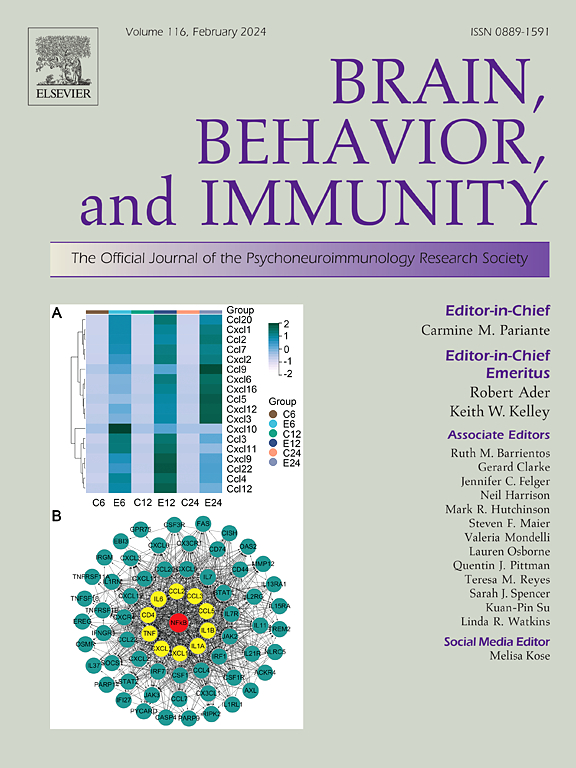脉络丛在尼曼-皮克病 C 型神经发病机制中的意义
IF 8.8
2区 医学
Q1 IMMUNOLOGY
引用次数: 0
摘要
背景:尼曼-皮克病C型(NPC)是一种极其罕见的疾病,以精神和神经系统的进行性表现为特征,可在婴儿晚期、青少年和青少年/成人中出现。我们研究了鼻咽癌脉络膜丛(一种保护性血-脑脊液屏障)的形态学特征,以及它们与神经退行性变、临床状况和循环标志物的关系。该研究还确定了脉络丛形态学是否能区分鼻咽癌和更普遍的疾病,精神分裂症(SZ)和双相情感障碍(BD),这两种疾病与青少年和成人发病的鼻咽癌有重叠的精神症状,并与误诊有关。方法:采用神经影像学、临床仪器和血浆蛋白定量(以炎症标志物为重点)对鼻咽癌患者进行评估。比较鼻咽癌(n = 17)、SZ (n = 20)、BD (n = 24)和健康对照(n = 106)患者的形态学特征(即脉络膜丛体积)。结果:脉络膜丛扩大(p )结论:脉络膜丛可能在鼻咽癌神经发病中起关键作用,并可作为监测鼻咽癌神经退行性和炎症过程的新的生物标志物。本文章由计算机程序翻译,如有差异,请以英文原文为准。
Implications of the choroid plexus in Niemann-Pick disease Type C neuropathogenesis
Background
Niemann-Pick Disease Type C (NPC) is an ultra-rare disorder characterized by progressive psychiatric and neurologic manifestations, with late infantile, juvenile, and adolescent/adult presentations. We examined morphological properties of the choroid plexus, a protective blood-cerebrospinal fluid barrier, in NPC, and their relationship with neurodegeneration, clinical status, and circulatory markers. This study also determined whether choroid plexus morphology differentiates between NPC and more prevalent illnesses, schizophrenia (SZ) and bipolar disorder (BD), which have overlapping psychiatric symptoms with adolescent and adult-onset NPC and are associated with misdiagnosis.
Methods
Patients with NPC were assessed using neuroimaging, clinical instruments, and plasma protein quantification focusing on inflammatory markers. Morphological properties (i.e., choroid plexus volumes) were compared between patients with NPC (n = 17), SZ (n = 20), BD (n = 24), and healthy controls (HCs, n = 106).
Results
Choroid plexus enlargement (p < 0.05) and reduced thalamic volumes (p < 0.05) were observed in NPC patients versus HCs and SZ or BD patients. A logistic regression model with choroid plexus and thalamic volumes as predictors yielded high prediction accuracy for NPC vs. HCs, NPC vs. SZ, and NPC vs. BD (area under the receiver operating characteristics curve [AUROC] of 1). Choroid plexus volumes were negatively correlated with left (p = 0.009–0.012) and right (p = 0.007–0.025) thalamic volumes, left (r = -0.69, p = 0.003) and right (r = -0.71, p = 0.002) crus I of the cerebellum, and greater severity on the NPC-Suspicion Index psychiatric subscale (ρ = 0.72, p = 0.042). Targeted protein expression quantification revealed differential expression of TGFA, HLA-DRA, TNFSF12, EGF, INFG, and IL-18 in NPC patients vs. HCs (p < 0.05), with higher choroid plexus volumes correlating with IL-18 levels (ρ = 0.71, p = 0.047).
Conclusion
The choroid plexus may play a critical role in NPC neuropathogenesis and serve as a novel biomarker for monitoring neurodegenerative and inflammatory processes in NPC.
求助全文
通过发布文献求助,成功后即可免费获取论文全文。
去求助
来源期刊
CiteScore
29.60
自引率
2.00%
发文量
290
审稿时长
28 days
期刊介绍:
Established in 1987, Brain, Behavior, and Immunity proudly serves as the official journal of the Psychoneuroimmunology Research Society (PNIRS). This pioneering journal is dedicated to publishing peer-reviewed basic, experimental, and clinical studies that explore the intricate interactions among behavioral, neural, endocrine, and immune systems in both humans and animals.
As an international and interdisciplinary platform, Brain, Behavior, and Immunity focuses on original research spanning neuroscience, immunology, integrative physiology, behavioral biology, psychiatry, psychology, and clinical medicine. The journal is inclusive of research conducted at various levels, including molecular, cellular, social, and whole organism perspectives. With a commitment to efficiency, the journal facilitates online submission and review, ensuring timely publication of experimental results. Manuscripts typically undergo peer review and are returned to authors within 30 days of submission. It's worth noting that Brain, Behavior, and Immunity, published eight times a year, does not impose submission fees or page charges, fostering an open and accessible platform for scientific discourse.

 求助内容:
求助内容: 应助结果提醒方式:
应助结果提醒方式:


